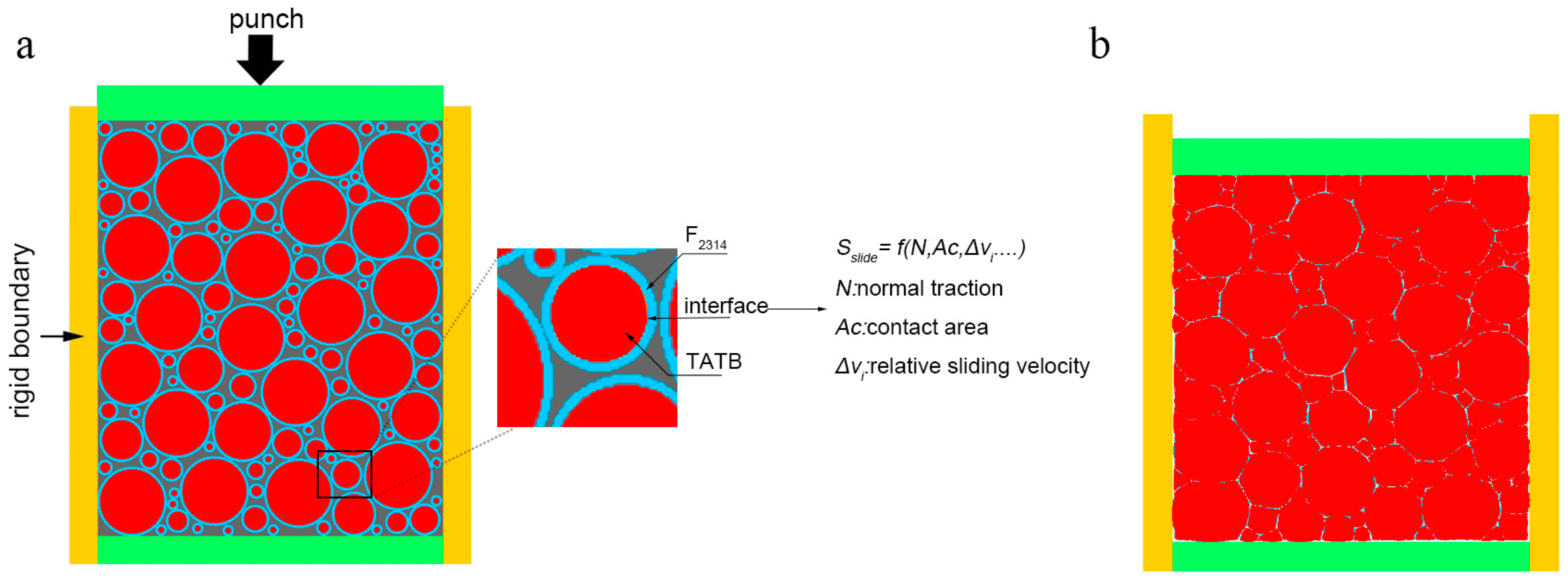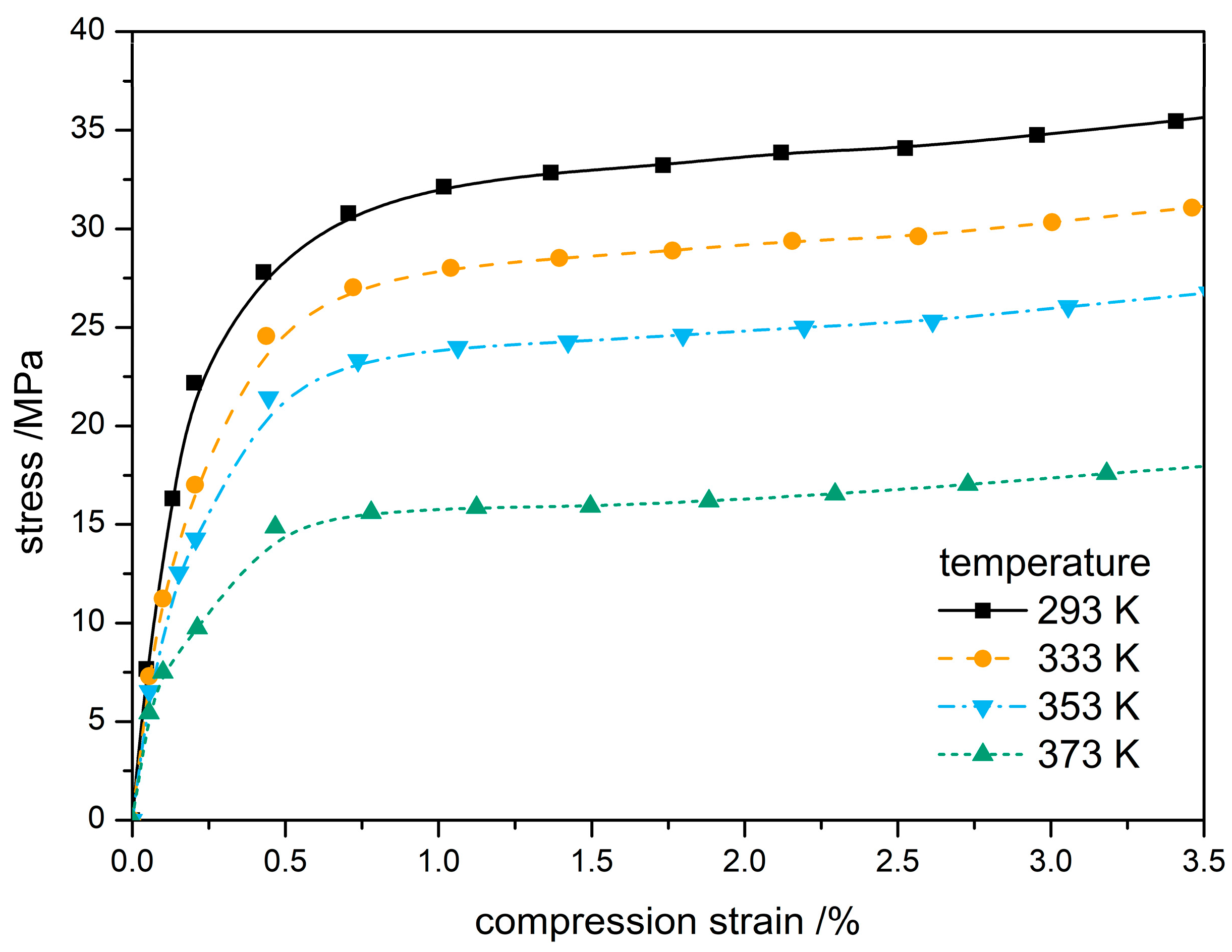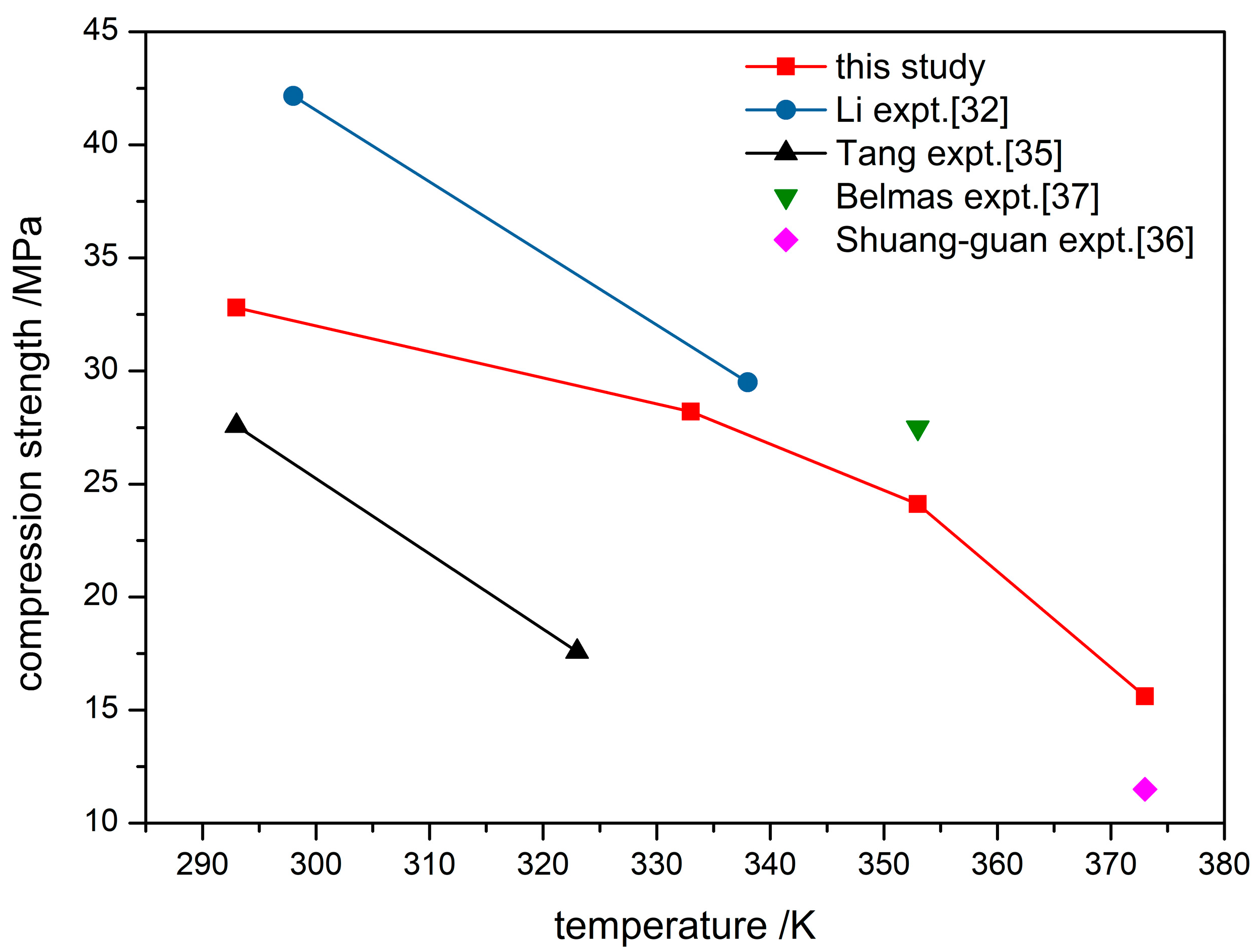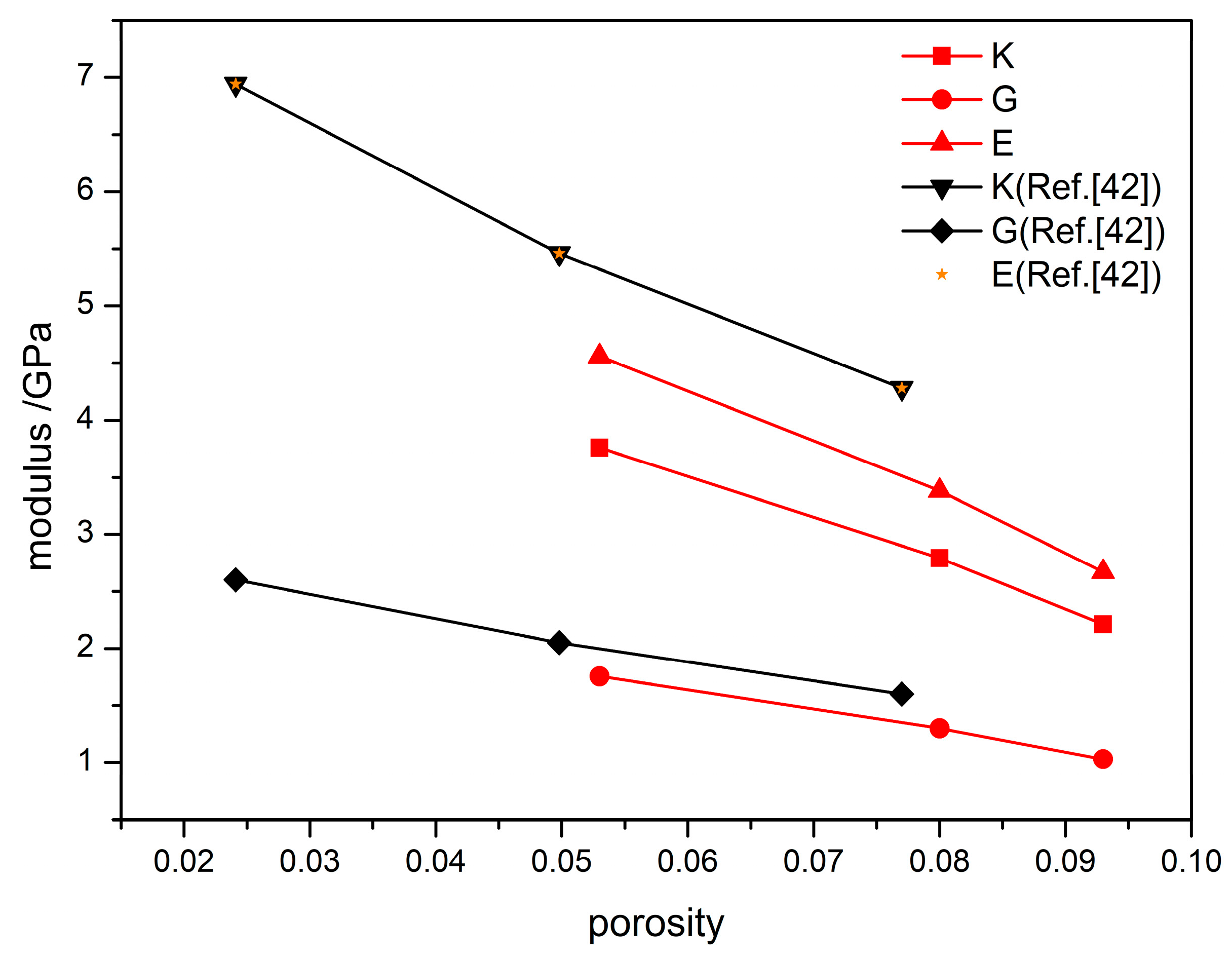Mesoscale Simulation to Study Constitutive Properties of TATB/F2314 PBX
Abstract
:1. Introduction
2. Methods and Simulation Model
2.1. Material Point Method
2.2. Interface friction Contact Algorithm
2.3. Simulation Model
3. Results and Discussion
3.1. Calculation of Mechanical Properties at Different Temperature
3.2. Mechanical Properties with Different Porosity
4. Conclusions
Author Contributions
Funding
Conflicts of Interest
References
- Skidmore, C.B.; Idar, D.J.; Buntain, G.A.; Son, S.F.; Sander, R.K. Aging and PBX 9502. In Proceedings of the Los Alamos National Laboratory Report LA-UR-98-1206, Conference on Life Cycles of Energetic Materials, Fullerton, CA, USA, 29 March–1 April 1998. [Google Scholar]
- Groves, S.; Cunningham, B. Tensile and Compressive Mechanical Properties of Billet Pressed LX17-1 as a Function of Temperature and Strain Rate. In Proceedings of the Lawrence Livermore National Laboratory Report UCRL-ID-137477, Office of Scientific & Technical Information Report, Livermore, CA, USA, 31 January 2000. [Google Scholar] [CrossRef]
- Govier, R.K.; Iii, G.T.G.; Blumenthal, W.R. Comparison of the Influence of Temperature on the High-Strain-Rate Mechanical Responses of PBX 9501 and EDC37. Metall. Mater. Trans. A 2008, 39, 535–538. [Google Scholar] [CrossRef]
- Lin, Y.; Xu, B.; Chen, R.; Qin, J.; Lu, F. Dynamic Mechanical Properties and Constitutive Relation of an Aluminized Polymer Bonded Explosive at Low Temperatures. Shock Vib. 2014, 2014, 6. [Google Scholar] [CrossRef]
- Guo, H.; Luo, J.R.; Shi, P.A.; Xu, J.G. Research on the fracture behavior of PBX under static tension. Def. Tech. 2014, 10, 154–160. [Google Scholar] [CrossRef]
- Xiao, Y.; Yi, S.; Zhen, Y.; Guo, L.; Yao, L. Characterization, modeling and simulation of the impact damage for polymer bonded explosives. Int. J. Impact Eng. 2017, 103, 149–158. [Google Scholar] [CrossRef]
- Bischoff, P.H.; Perry, S.H. Compressive behavior of concrete at high strain rates. Mater. Struct. 1991, 24, 425–450. [Google Scholar] [CrossRef]
- Bennettb, J.G.; Haberman, K.S.; Johnson, J.N.; Asay, B.W.; Henson, B.F. A constitutive model for the non-shock ignition and mechanical response of high explosives. J. Mech. Phys. Solids 1998, 46, 2303–2322. [Google Scholar] [CrossRef]
- Smith, G.D.; Menikoff, R. Molecular dynamics simulation study of elastic properties of HMX. J. Chem. Phys. 2003, 119, 7417–7426. [Google Scholar] [CrossRef]
- Dmitry, B.; Oleg, B.; Smith, G.D.; Sewell, T.D.; Dattelbaum, D.M.; Stevens, L.L. A molecular dynamics simulation study of crystalline 1,3,5-triamino-2,4,6-trinitrobenzene as a function of pressure and temperature. J. Chem. Phys. 2009, 131, 10782. [Google Scholar] [CrossRef]
- Byrd, E.F.C.; Rice, B.M. Ab Initio Study of Compressed 1,3,5,7-Tetranitro-1,3,5,7-tetraazacyclooctane (HMX), Cyclotrimethylenetrinitramine (RDX), 2,4,6,8,10,12-Hexanitrohexaazaisowurzitane (CL-20), 2,4,6-Trinitro-1,3,5-benzenetriamine (TATB), and Pentaerythritol Tetranitrate (PETN). J. Phys. Chem. C 2007, 111, 2787–2796. [Google Scholar] [CrossRef]
- Vu-Bac, N.; Areias, P.M.A.; Rabczuk, T. A multiscale multisurface constitutive model for the thermo-plastic behavior of polyethylene. Polymer 2016, 105, S0032386116309417. [Google Scholar] [CrossRef]
- Sulsky, D.; Chen, Z.; Schreyer, H.L. A particle method for history-dependent materials. Comput. Methods Appl. Mech. 1993, 118, 179–196. [Google Scholar] [CrossRef]
- Sulsky, D.; Zhou, S.J.; Schreyer, H.L. Application of a particle-in-cell method to solid mechanics. Comput. Phys. Commun. 1995, 87, 236–252. [Google Scholar] [CrossRef]
- Sulsky, D.; Schreyer, H.L. Axisymmetric form of the material point method with applications to upsetting and Taylor impact problems. Comput. Methods Appl. M 1996, 139, 409–429. [Google Scholar] [CrossRef]
- Banerjee, B.; Guilkey, J.E.; Harman, T.B.; Schmidt, J.A.; Mcmurtry, P.A. Simulation of impact and fragmentation with the material point method. In Proceedings of the 11th International Conference on Fracture, Turin, Italy, 20–25 March 2005. [Google Scholar]
- Banerjee, B. Validation of the Material Point Method and Plasticity with Taylor Impact Tests; University of Utah C-SAFE Report # C-SAFE-CD-IR-04-004; University of Utah: Salt Lake City, UT, USA, 2004. [Google Scholar]
- Banerjee, B. Material point method simulations of fragmenting cylinders. In Proceedings of the 17th ASCE Engineering Mechanics Conference, Newark, DE, USA, 13–16 June 2004. [Google Scholar]
- Sun, J.; Dong, H.S.; Zheng, P.S.; Zhang, L. Study on Fluoropolymer F2314 Bonded HMX. Chin. J. Energy Mater. 2000, 8, 155–157. [Google Scholar]
- Nairn, J.A.; Bardenhagen, S.G.; Smith, G.D. Generalized contact and improved frictional heating in the material point method. Comput. Part. Mech. 2017, 1–13. [Google Scholar] [CrossRef]
- NarinMPM Simulation Package Is Freely. Each Element Contained 4 Material Points. Update Strain Average Option Was Used. Available online: http://nairn.mse.utah.edu/ (accessed on 29 September 2019).
- Wang, C.; Chen, L.; Liu, Q.; Pi, Z.D.; Hu, X.M. Numerical simulation for analyzing shock to ignition of PBXs with different compositions in meso-structural level. Explos. Shock Waves 2014, 106, 411–420. [Google Scholar] [CrossRef]
- Seidel, G.D.; Allen, D.H.; Helms, K.L.E.; Groves, S.E. A model for predicting the evolution of damage in viscoelastic particle-reinforced composites. Mech. Mater. 2005, 37, 163–178. [Google Scholar] [CrossRef]
- Davande, H.; Bedrov, D.; Smith, G.D. Thermodynamic, Transport, and Viscoelastic Properties of PBX-9501 Binder: A Molecular Dynamics Simulations Study. J. Energ. Mater. 2008, 26, 115–138. [Google Scholar] [CrossRef]
- Zhu, W.; Xiao, J.J.; Huang, H.; Ma, X.F.; Li, J.S.; Xiao, H.M. Temperature effect on mechanical properties of TATB and TATB/F2311 PBX by molecular dynamics simulation. J. Nanjing Univ. Sci. Technol. 2007, 31, 243–247. [Google Scholar]
- Hobbs, M.L.; Baer, M.R.; Gross, R.J. A constitutive mechanical model for energetic materials. In Proceedings of the Sandia National Laboratory Report SAND-94-0363C, International Pyrotechnics Seminar, Colorado Springs, CO, USA, 25–29 July 1994. [Google Scholar]
- Jing, S.M. Study on the Effective Mechanical Properties and Constitutive Relations of PBX. Master’s Thesis, China Academy of Engineering Physics, Mianyang, China, 2009. [Google Scholar]
- Barua, A.; Horie, Y.; Zhou, M. Energy localization in HMX-Estane polymer-bonded explosives during impact loading. J. Appl. Phys. 2012, 111, 399–586. [Google Scholar] [CrossRef]
- Dai, K.D.; Liu, Y.L.; Chen, P.W.; Tian, Y. Finite element simulation on effective elastic modulus of PBX explosives. Trans. Beijing Inst. Technol. 2012, 32, 1154–1158. [Google Scholar] [CrossRef]
- Skidmore, C.B.; Phillips, D.S.; Son, S.F.; Asay, B.W. Characterization of HMX particles in PBX 9501. In Shock Compression of Condensed Matter-1997; Schmidt, S.C., Dandekar, D.P., Forbes, J.W., Eds.; AIP Press: New York, NY, USA, 1998; p. 579. [Google Scholar] [CrossRef]
- Guo, H.F.; Wu, Y.Q.; Huang, F.L. Wide range temperature-dependent deformation and fracture mechanisms for 8701 under dynamic and static loading. RSC Adv. 2018, 8, 14293–14299. [Google Scholar] [CrossRef]
- Li, J.L.; Lu, F.Y.; Chen, R.; Qin, J.G.; Zhao, P.D.; Lan, L.G.; Jing, S.M. Dynamic Behavior of Three PBXs with Different Temperatures. J. Dyn. Behav. Mater. 2011, 1, 135–140. [Google Scholar] [CrossRef]
- Shu, Y.; Yi, Y.; Huo, J.; Liu, N.; Wang, K.; Lu, Y.; Wang, X.; Wu, Z.; Shu, Y.; Zhang, S. Interactions between poly-(phthalazinone ether sulfone ketone) (PPESK) and TNT or TATB in polymer bonded explosives: A molecular dynamic simulation study. J. Mol. Model. 2017, 23, 334. [Google Scholar] [CrossRef]
- Tang, M.F.; Wen, M.P.; Tu, X.Z. Influence and Mechanism of High Temperature and Mechanical Stress on the Mechanical Behaviors of PBXs. Chin. J. Energy Mater. 2018, 26, 150–155. [Google Scholar] [CrossRef]
- Tang, W.; Yuan, H.W.; Wen, M.P. Quasi-static tension-compression nonlinear constitutive model of TATB-based PBX and its application. Chin. J. Energy Mater. 2018, 26, 701–707. [Google Scholar] [CrossRef]
- Shang-Guan, P.J. Digital Image Correlation Method on Studying Compressive Mechanical Properties of PBX in Wide Temperature Range. Master’s Thesis, China Academy of Engineering Physics, Mianyang, China, 2017. [Google Scholar]
- Belmas, R.; Plotard, J.P. Physical Origin of Hot Spots in Pressed Explosive Compositions. J. Phys. IV 1995, 5, 61–87. [Google Scholar] [CrossRef]
- Chen, R.; Fang-Yun, L.U.; Lin, Y.L.; Wang, R.F. Mechanical Behavior and Constitutive Model of Pressed Aluminized Explosive. Chin. J. Energy Mater. 2007, 15, 460–463. [Google Scholar] [CrossRef]
- Dai, B. Study on Structure Evolution and Stress Response of Modeling Particles in TATB Molding Process. Master’s Thesis, China Academy of Engineering Physics, Mianyang, China, 2015. [Google Scholar]
- Ravindran, S.; Tessema, A.; Kidane, A. Multiscale damage evolution in polymer bonded sugar under dynamic loading. Mech. Mater. 2017, 114, 97–106. [Google Scholar] [CrossRef]
- Jing, S.M.; Ming, L.I.; Long, X.P. On Predicting Effective Elastic Modulus of PBX by Modified Hashin-Shtrikman Model. Chin. J. Energy Mater. 2009, 17, 664–667. [Google Scholar] [CrossRef]
- Yang, K.; Wu, Y.; Huang, F. Numerical simulations of microcrack-related damage and ignition behavior of mild-impacted polymer bonded explosives. J. Hazard. Mater. 2018, 356, 34. [Google Scholar] [CrossRef] [PubMed]
- Wei, X.W.; Li, M.; Li, J.-M.; Tu, X.-Z.; Zhou, M.L. Influence of Pore Properties on Effective Elastic Modulus of TATB Based Polymer Bonded Explosive. Chin. J. Energy Mater. 2014, 22, 493–497. [Google Scholar] [CrossRef]









| Material | Parameters | Values |
|---|---|---|
| TATB | shear modulus (GPa) | 11.5 |
| density (g/cm3) | 1.934 | |
| yield stress (GPa) | 0.80 | |
| 0 | ||
| 0 | ||
| (m/s) | 2340 | |
| Grüneisen | 1.60 | |
| 2.32 | ||
| 0 | ||
| 0 | ||
| F2314 | bulk modulus (GPa) | 0.33 |
| shear modulus (GPa) | 0.07 | |
| density (g/cm3) | 2.02 | |
| 0.08936 | ||
| (GPa) | 0.27 |
| Temperature (K) | K (GPa) | G (GPa) | E (GPa) |
|---|---|---|---|
| 293 1 | 2.79 | 1.30 | 3.38 |
| 293 2 | 2.22 | 2.21 | 4.98 |
| 298 3 | – | – | 3.20 |
| 323 3 | – | – | 2.92 |
| 333 1 | 2.76 | 1.09 | 2.90 |
| 338 3 | – | – | 2.48 |
| 353 1 | 2.77 | 0.98 | 2.64 |
| 373 1 | 2.63 | 0.77 | 2.10 |
| Temperature (K) | Simulation Compression Strength (MPa) |
|---|---|
| 293 | 32.8 |
| 333 | 28.2 |
| 353 | 24.1 |
| 373 | 15.6 |
© 2019 by the authors. Licensee MDPI, Basel, Switzerland. This article is an open access article distributed under the terms and conditions of the Creative Commons Attribution (CC BY) license (http://creativecommons.org/licenses/by/4.0/).
Share and Cite
Ge, S.; Zhang, W.; Sang, J.; Yuan, S.; Lo, G.V.; Dou, Y. Mesoscale Simulation to Study Constitutive Properties of TATB/F2314 PBX. Materials 2019, 12, 3767. https://doi.org/10.3390/ma12223767
Ge S, Zhang W, Sang J, Yuan S, Lo GV, Dou Y. Mesoscale Simulation to Study Constitutive Properties of TATB/F2314 PBX. Materials. 2019; 12(22):3767. https://doi.org/10.3390/ma12223767
Chicago/Turabian StyleGe, Siyu, Wenying Zhang, Jian Sang, Shuai Yuan, Glenn V. Lo, and Yusheng Dou. 2019. "Mesoscale Simulation to Study Constitutive Properties of TATB/F2314 PBX" Materials 12, no. 22: 3767. https://doi.org/10.3390/ma12223767





